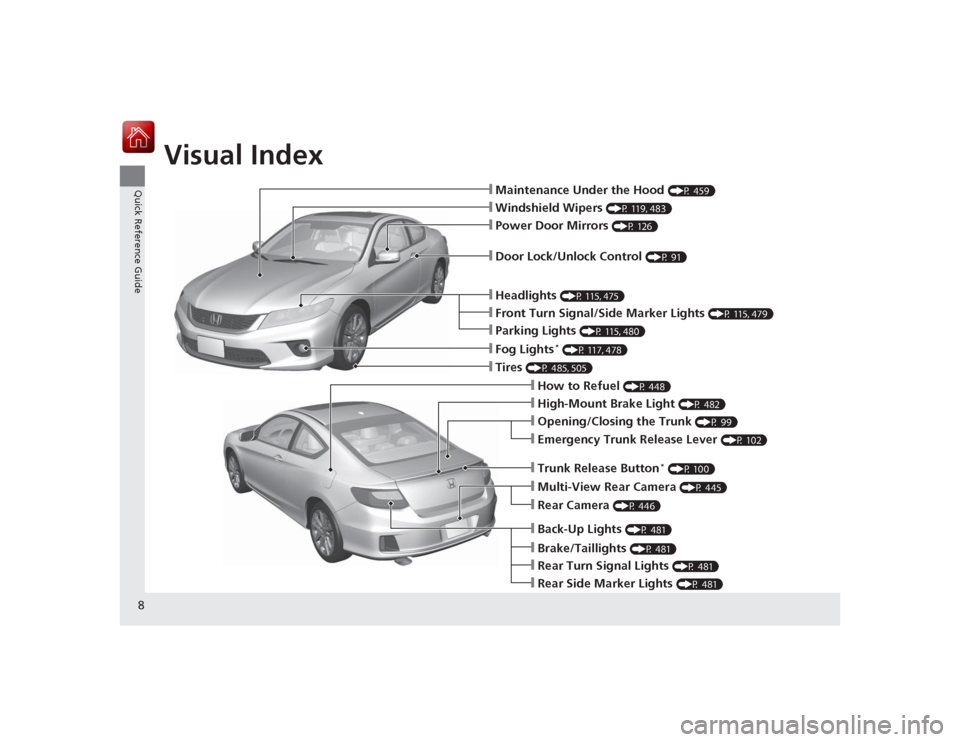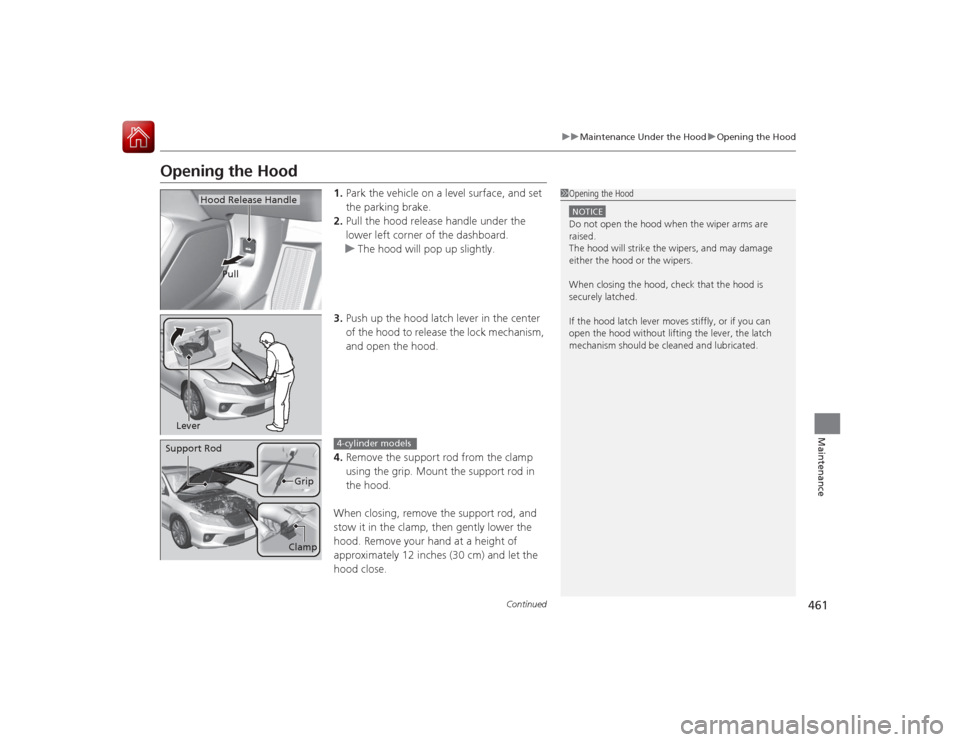2015 HONDA ACCORD COUPE hood open
[x] Cancel search: hood openPage 4 of 557

Contents
Child Safety P. 52Exhaust Gas Hazard P. 64Safety Labels P. 65Opening and Closing the Trunk P. 99 Security System P. 103 Opening and Closing the Windows P. 106
Operating the Switches Around the Steering Wheel P. 110 Adjusting the Mirrors P. 125
Interior Lights/Interior Convenience Items P. 135 Climate Control System P. 144Audio Error Messages P. 264General Information on the Audio System P. 270
Bluetooth® HandsFreeLink ® P. 314, 351 Compass
* P. 389
When Driving P. 401 Braking P. 440Parking Your Vehicle P. 444
Accessories and Modifications P. 450Maintenance Under the Hood P. 459 Replacing Light Bulbs P. 475
Checking and Maintaining Tires P. 485 Battery P. 494 Remote Transmitter Care P. 495
Cleaning P. 498Engine Does Not Start P. 511 Jump Starting P. 514Shift Lever Does Not Move P. 517
Fuses P. 524 Emergency Towing P. 527Devices that Emit Radio Waves P. 535 Reporting Safety Defects P. 536
Authorized Manuals P. 541 Customer Service Information P. 542
Quick Reference Guide
P. 4
Safe Driving
P. 27
Instrument Panel
P. 67
Controls
P. 85
Features
P. 149
Driving
P. 391
Maintenance
P. 451
Handling the Unexpected
P. 503
Information
P. 529
Index
P. 546
Page 9 of 557

Visual Index
8Quick Reference Guide
❙Maintenance Under the Hood
(P 459)
❙Windshield Wipers
(P 119, 483)
❙Tires
(P 485, 505)
❙Door Lock/Unlock Control
(P 91)
❙Power Door Mirrors
(P 126)
❙Headlights
(P 115, 475)
❙How to Refuel
(P 448)
❙High-Mount Brake Light
(P 482)
❙Emergency Trunk Release Lever
(P 102)
❙Opening/Closing the Trunk
(P 99)
❙Parking Lights
(P 115, 480)
❙Front Turn Signal/Side Marker Lights
(P 115, 479)
❙Fog Lights
* (P 117, 478)
❙Multi-View Rear Camera
(P 445)
❙Back-Up Lights
(P 481)
❙Rear Camera
(P 446)
❙Trunk Release Button
* (P 100)
❙Brake/Taillights
(P 481)
❙Rear Side Marker Lights
(P 481)
❙Rear Turn Signal Lights
(P 481)
Page 23 of 557

22Quick Reference Guide
Handling the Unexpected
(P 503)
Flat Tire
(P 505)
● Park in a safe location and replace the
flat tire with the compact spare tire in the
trunk.
Indicators Come On (P 520)
●Identify the indicator and consult the
owner's manual.
Engine Won't Start (P 511)
● If the battery is dead, jump start using a
booster battery.Blown Fuse
(P 524)
● Check for a blown fuse if an electrical
device does not operate.
Overheating
(P 518)
● Park in a safe location. If you do not see
steam under the hood, open the hood,
and let the engine cool down.
Emergency Towing (P 527)
●Call a professional towing service if you
need to tow your vehicle.
Page 104 of 557

103
Continued
Controls
Security SystemImmobilizer SystemThe immobilizer system prevents a key that has not been pre-registered from
starting the engine. Each key contains electronic transmitters that use electronic
signals to verify the key.
Pay attention to the following when inserting the key into the ignition switch or
pressing the ENGINE START/STOP button:
• Do not allow objects that emit strong radio waves near the ignition switch or the
ENGINE START/STOP button.
• Make sure the key is not covered by or touching a metal object.
• Do not bring a key from another vehicle's immobilizer system near the ignition
switch.Security System AlarmThe security system alarm activates when the trunk, hood or doors are forcibly
opened. The alarm does not go off if the trunk or doors are opened with the key,
remote transmitter or smart entry system.
However, the alarm goes off when a door is opened with the key, then the shift
lever is moved out of
(P
(automatic transmission/CVT models) or the hood is
opened before the ignition switch is turned to ON
( w
*1.
■When the security system alarm activates
The horn sounds intermittently and all the exterior lights flash.■To deactivate the security system alarm
Unlock the vehicle using the remote transmitter, or smart entry system. The system,
along with the horn and flashing lights, is deactivated.*1: Models with the smart entry system have an ENGINE START/STOP button instead of an
ignition switch.
1 Immobilizer SystemNOTICELeaving the ignition key in the vehicle can result in
theft or accidental movement of the vehicle.
Always take the ignition key with you whenever you
leave the vehicle unattended.
Do not alter the system or add other devices to it.
Doing so may damage the system and make your
vehicle inoperable.1Security System Alarm
The security alarm continues for a maximum of two
minutes until the security system deactivates.
Page 105 of 557

uuSecurity System uSecurity System Alarm
104Controls
■Setting the securi ty system alarm
The security system alarm automatically sets when the following conditions have
been met:
• The ignition switch is in LOCK
(0
*1, and the key has been removed from the
ignition switch.
• The hood and trunk are closed.
• Both doors are locked from outside with the key, the remote transmitter, or smart
entry system.
■When the security system alarm sets
The security system alarm indicator in the instrument panel blinks. When the
blinking interval changes after about 15 seconds, the security system is set.■To cancel the security system alarm
The security system alarm is canceled when the vehicle is unlocked using the remote transmitter, smart entry system or the ignition switch is turned to ON
(w
*1. The
security system indicator goes off at the same time.
*1: Models with the smart entry system have an ENGINE START/STOP button instead of an
ignition switch.
1 Security System Alarm
Do not set the security system alarm when someone
is in the vehicle or a window is open. The system can
accidentally activate when:•Unlocking the door with the lock tab.•Opening the trunk with th e trunk release or the
emergency trunk opener.•Opening the hood with the hood release.•Moving the shift lever out of
( P.
If the battery goes dead after you have set the
security system alarm, the security alarm may go off
once the battery is recharged or replaced.
If this occurs, deactivate the security system alarm by
unlocking a door using the key or remote transmitter.
Do not attempt to alter this system or add another
device to it.
Automatic transmission/CVT models
Page 393 of 557

392Driving
Before DrivingDriving PreparationCheck the following items before you start driving.
•Make sure there are no obstructions on the windows, door mirrors, exterior
lights, or other parts of the vehicle.
u Remove any frost, snow, or ice.
u Remove any snow on the roof, as this can slip down and obstruct your field of
vision while driving. If frozen solid, remove ice once it has softened.
u When removing ice from around the wheels, be sure not to damage the wheel
or wheel components.
• Make sure the hood is securely closed.
u If the hood opens while driving, your front view will be blocked.
• Make sure the tires are in good condition.
u Check air pressure, check for damage and excessive wear.
2 Checking and Maintaining Tires P. 485
•Make sure there are no people or objects behind or around the vehicle.
u There are blind spots from the inside.■
Exterior Checks
1Exterior ChecksNOTICEWhen doors are frozen shut, use warm water around
the door edges to melt any ice. Do not try to force
them open, as this can damage the rubber trim
around the doors. When done, wipe dry to avoid
further freezing.
Do not pour warm water into the key cylinder.
You will be unable to inse rt the key if the water
freezes in the hole.
Heat from the engine and exhaust can ignite
flammable materials left under the hood, causing a
fire. If you've parked your vehicle for an extended
period, inspect and remove any debris that may have
collected, such as dried grass and leaves that have
fallen or have been carried in for use as a nest by a
small animal.
Also check under the hood for leftover flammable
materials after you or someone else has performed
maintenance on your vehicle.
Page 452 of 557

451
Maintenance
This chapter discusses basic maintenance.
Before Performing MaintenanceInspection and Maintenance ............ 452Safety When Performing Maintenance..... 453Parts and Fluids Used in Maintenance Service ........................................... 454
Maintenance Minder
TM..................... 455
Maintenance Under the Hood
Maintenance Items Under the Hood ..... 459Opening the Hood ........................... 461
Recommended Engine Oil ................ 463
Oil Check ......................................... 464
Adding Engine Oil ............................ 466Changing the Engine Oil and Oil Filter ..... 467
Engine Coolant ................................ 469
Transmission Fluid ............................ 471
Brake/Clutch Fluid ............................ 473
Refilling Window Washer Fluid......... 474
Replacing Light Bulbs ....................... 475Checking and Maintaining Wiper
Blades .......................................... 483Checking and Maintaining Tires
Checking Tires ................................. 485Tire and Loading Information Label ...... 486Tire Labeling .................................... 486DOT Tire Quality Grading (U.S. Vehicles)....... 488Wear Indicators................................ 490 Tire Service Life ................................ 490
Tire and Wheel Replacement ........... 491
Tire Rotation .................................... 492
Winter Tires ..................................... 493
Battery ............................................... 494
Remote Transmitter Care
Replacing the Button Battery ........... 495
Climate Control System Maintenance ... 497
Cleaning
Interior Care .................................... 498
Exterior Care.................................... 500
Page 462 of 557

461
uuMaintenance Under the Hood uOpening the Hood
Continued
Maintenance
Opening the Hood
1. Park the vehicle on a level surface, and set
the parking brake.
2. Pull the hood release handle under the
lower left corner of the dashboard.
u The hood will pop up slightly.
3. Push up the hood latch lever in the center
of the hood to release the lock mechanism,
and open the hood.
4. Remove the support rod from the clamp
using the grip. Mount the support rod in
the hood.
When closing, remove the support rod, and
stow it in the clamp, then gently lower the
hood. Remove your hand at a height of
approximately 12 inches (30 cm) and let the
hood close.
1 Opening the HoodNOTICEDo not open the hood when the wiper arms are
raised.
The hood will strike the wipers, and may damage
either the hood or the wipers.
When closing the hood, check that the hood is
securely latched.
If the hood latch lever moves stiffly, or if you can
open the hood without lifting the lever, the latch
mechanism should be cleaned and lubricated.
Hood Release Handle
Pull
LeverSupport Rod
Grip
Clamp
4-cylinder models